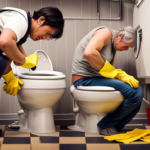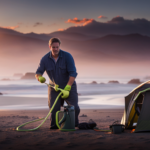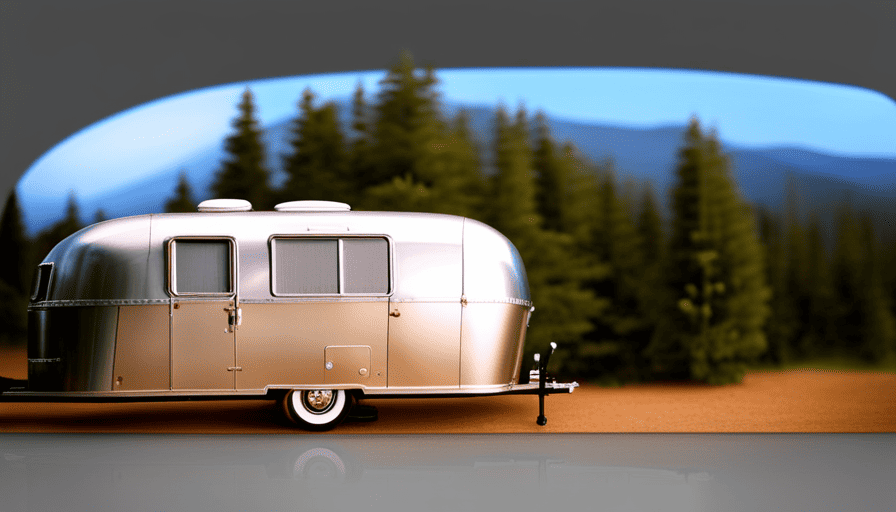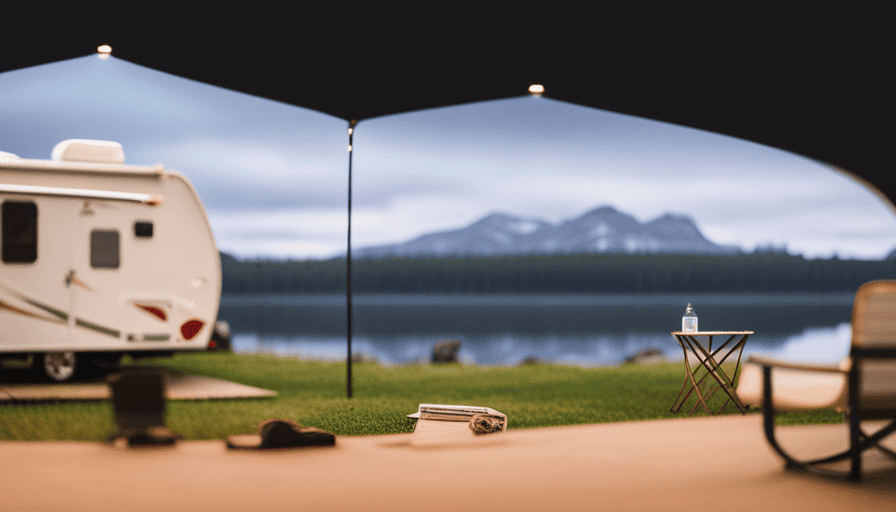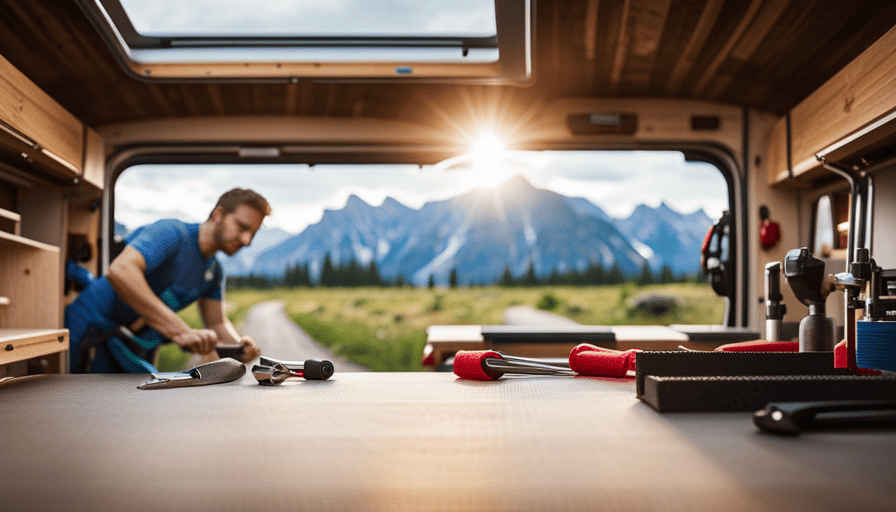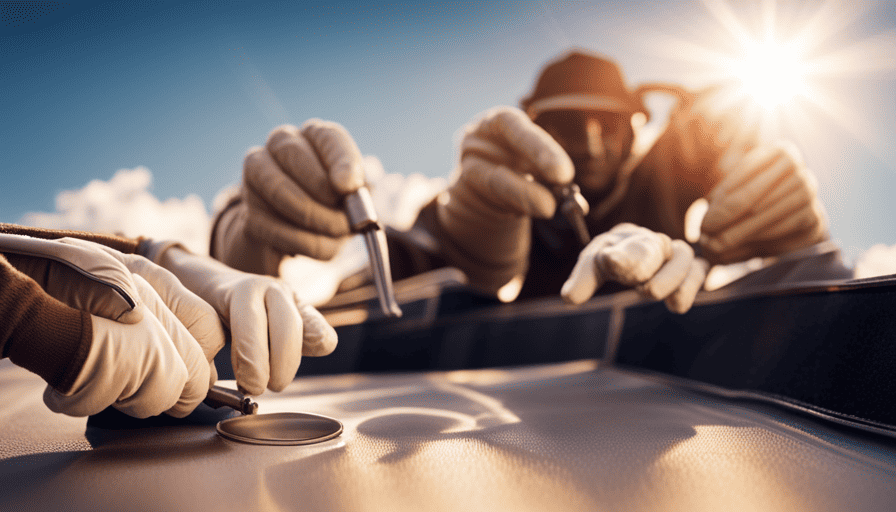Picture this: You’re enjoying the beauty of nature in your RV, and suddenly disaster strikes – your toilet gets clogged. Trust me, I’ve been there.
As an experienced camper, I know how frustrating and inconvenient a clogged toilet can be. But fear not, because I have the knowledge and expertise to help you clear that clog and get back to enjoying your outdoor adventure.
Now, here’s the truth: camper toilets can be prone to clogs due to their smaller pipes and limited flushing power. But don’t worry, I’ve got a range of effective solutions to unclog that toilet and get it back in working order.
From using a plunger to trying a plumbing snake or auger, I’ll guide you through each step with precision and ease.
But that’s not all. I’ll also share homemade drain cleaner recipes, such as using hot water and dish soap or baking soda and vinegar, that can work wonders in clearing those stubborn clogs.
And if all else fails, I’ll even provide tips on when it’s time to call in a professional plumber.
So, let’s get started and get that clogged camper toilet back to pristine condition. Your outdoor adventure awaits!
Key Takeaways
- Signs of a clogged camper toilet include improper water drainage, a higher-than-usual water level in the bowl, gurgling sounds, and foul odors.
- Preventive measures to avoid future clogs include using RV-friendly toilet paper and avoiding flushing anything other than human waste and toilet paper.
- Using a plunger, a plumbing snake or auger, and homemade drain cleaners are effective solutions to unclog a camper toilet.
- Regularly maintaining and cleaning the camper’s plumbing system can prevent future clogs.
Identify the Source of the Clog
Now it’s time for you to put on your detective hat and figure out where that pesky clog in your camper toilet is coming from! Identifying common causes, signs, and symptoms of a clogged camper toilet is essential in order to effectively clear it.
One common cause of clogs is excessive toilet paper usage. If you notice that the water isn’t draining properly or the bowl fills up higher than usual, it’s a sign that there might be a clog. Another indicator is when you hear gurgling sounds coming from the toilet or notice a foul odor. These are all signs that a clog is present and action needs to be taken.
Preventive measures can help avoid clogs in the future. Use only RV-friendly toilet paper that dissolves easily. Also, avoid flushing anything other than human waste and toilet paper down the toilet. By following these preventive measures, you can minimize the chances of dealing with a clogged camper toilet again.
Now, let’s move on to the next section about using a plunger to unclog the toilet.
Use a Plunger to Unclog the Toilet
First, grab a plunger and give it a go to tackle the unwelcome blockage in your cozy mobile restroom. Using a plunger is a common and effective method for unclogging a camper toilet. This simple tool creates pressure and suction to dislodge the clog and restore proper flow. Let’s discuss the pros and cons of using a plunger for toilet unclogging.
Pros of using a plunger:
- Cost-effective: Plungers are inexpensive and readily available at most stores.
- Easy to use: With a few simple plunges, you can often clear minor clogs quickly.
- Versatile: Plungers work well for both solid and liquid waste clogs.
Cons of using a plunger:
- Messy: Plunging can cause water and waste to splash, so it’s important to take precautions.
- Limited effectiveness: Plungers may not be effective for severe or stubborn clogs.
- Potential damage: Vigorous plunging can damage the toilet if not done correctly.
To avoid common mistakes when using a plunger, remember to create a good seal between the plunger and the toilet bowl, and use gentle but firm pressure. Additionally, avoid using excessive force, as it can cause the water to overflow or damage the toilet.
Transitioning into the subsequent section, if the plunger doesn’t solve the issue, it’s time to try a plumbing snake or auger.
Try a Plumbing Snake or Auger
If you’re still struggling with a pesky blockage, it’s time to get your hands on a handy plumbing snake or auger. These tools are great alternatives to a plunger when it comes to unclogging a camper toilet.
A plumbing snake, also known as a drain auger, is a long, flexible metal cable with a coiled end. It’s designed to navigate through the pipes and break up any stubborn clogs. Augers, on the other hand, are similar to snakes but have a rotating mechanism that helps to dislodge the blockage more effectively.
When using a plumbing snake or auger, it’s important to follow the manufacturer’s instructions carefully. Insert the tool into the toilet bowl and gently push it down, rotating it as you go. If you encounter resistance, apply a little more pressure to break through the clog. Once you feel the blockage give way, slowly pull the snake or auger out, being cautious not to scratch the porcelain.
Common causes of clogged camper toilets include excessive toilet paper usage, foreign objects like wipes or feminine hygiene products being flushed, or a build-up of waste and debris over time. By using a plumbing snake or auger, you can effectively remove these blockages and restore your toilet’s functionality.
Now, let’s move on to the next step in unclogging your camper toilet: using hot water and dish soap.
Use Hot Water and Dish Soap
To add depth and hook the audience, you should explore the effectiveness of using hot water and dish soap to resolve your issue.
When it comes to clearing a clogged camper toilet, this method can be quite effective. First, gather a large pot of hot water and a generous amount of dish soap. Carefully pour the hot water into the toilet bowl, making sure not to overflow it. The hot water helps to soften and break down any solid waste or debris that may be causing the clog.
Next, add a few squirts of dish soap into the bowl. The soap acts as a lubricant, allowing the clog to slide through the pipes more easily. Let the hot water and dish soap mixture sit in the bowl for about 10-15 minutes to allow them to work their magic.
Then, flush the toilet and see if the clog has cleared. If not, you may need to try alternative methods or consider calling a professional plumber.
In the next section, we will discuss how to create a homemade drain cleaner.
Create a Homemade Drain Cleaner
One effective way to address the issue is by creating a homemade drain cleaner. When faced with a clogged camper toilet, it’s important to consider homemade drain cleaner alternatives and natural remedies for unclogging toilets.
Not only are these methods cost-effective, but they’re also environmentally friendly. To create a homemade drain cleaner, start by mixing equal parts baking soda and vinegar in a bowl. The chemical reaction between these two ingredients will produce a foaming effect, which helps to break down any obstructions in the toilet pipes.
Once the foaming subsides, pour a pot of boiling water down the toilet to flush away the loosened debris. This homemade drain cleaner is gentle yet effective, making it a reliable solution for clearing a clogged camper toilet.
Transitioning into the next section about utilizing a wet/dry vacuum, it’s important to note that if the homemade drain cleaner method doesn’t work, it may be necessary to explore other options to resolve the issue.
Utilize a Wet/Dry Vacuum
When dealing with a stubborn blockage, try using a wet/dry vacuum to suck out the debris and restore the flow in your plumbing system. This method is highly effective and can save you from the hassle of disassembling the toilet or using harmful chemicals.
Here are three reasons why utilizing a wet/dry vacuum is a great option:
-
Versatility: Wet/dry vacuums aren’t just useful for unclogging toilets, but they can also be used for other cleaning tasks in your camper. From cleaning up spills to removing dirt and debris from carpets, this versatile tool is a must-have for any camper owner.
-
Efficiency: Unlike plungers or drain cleaners, a wet/dry vacuum provides a powerful suction force that can effectively remove even the most stubborn clogs. It quickly eliminates blockages, allowing water to flow freely through the pipes again.
-
Safety Precautions: When using a wet/dry vacuum, it’s important to follow certain safety precautions. Make sure the vacuum is suitable for wet operations, wear protective gloves, and avoid getting the vacuum wet to prevent any electrical hazards.
Using a wet/dry vacuum is just one method to clear a clogged camper toilet. Another effective approach is to use baking soda and vinegar. By combining these two household ingredients, you can create a powerful cleaning solution that’ll help dissolve the blockage.
Use Baking Soda and Vinegar
Combine baking soda and vinegar for a fizzing reaction that can help break down stubborn blockages in your plumbing system, leaving it flowing smoothly again. This method isn’t just effective for unclogging camper toilets, but it can also be used to unclog other household drains.
To start, pour half a cup of baking soda down the clogged toilet drain. Make sure it goes directly into the drain instead of sitting on the surface. Then, pour half a cup of vinegar down the drain and quickly cover it with a cloth or drain plug to trap the fizzing reaction inside. Let it sit for about 30 minutes, allowing the mixture to work its magic on the clog.
After the designated time, remove the cover and flush the toilet. The combination of baking soda and vinegar will have loosened the blockage and cleared the pipes, ensuring a smooth flow of water. This method is an excellent alternative to using chemicals, as it’s eco-friendly and safe for your plumbing system.
Now that you’ve tried the baking soda and vinegar method, let’s explore another option for unclogging your camper toilet – trying a chemical drain cleaner.
Try a Chemical Drain Cleaner
Using a chemical drain cleaner is like unleashing a powerful force that obliterates even the most stubborn obstructions in your plumbing system, allowing water to flow freely once again.
Chemical drain cleaners are readily available in stores and can be an effective solution for clearing a clogged camper toilet. One of the main advantages of using a chemical drain cleaner is its convenience. It’s a quick and easy fix that requires minimal effort.
Additionally, these cleaners are designed to dissolve hair, grease, and other organic materials, making them effective against various types of clogs.
However, it’s important to consider the potential drawbacks of using a chemical drain cleaner. They’re made up of harsh chemicals that can be harmful to both humans and the environment. They can release toxic fumes and may cause damage to your plumbing system if used improperly.
Therefore, it’s crucial to follow the instructions carefully and take necessary precautions when using a chemical drain cleaner. If the clog persists or if you’re unsure about using these cleaners, it’s best to call a professional plumber who can provide expert assistance in resolving the issue.
Call a Professional Plumber
Hiring a professional plumber is the best solution to ensure your plumbing problem is fixed quickly and effectively. When it comes to a clogged camper toilet, sometimes the DIY solutions just won’t cut it. Here are a few reasons why hiring a professional is your best bet:
-
Expertise: Professional plumbers have the knowledge and experience to accurately diagnose and fix the issue. They can quickly identify the cause of the clog and determine the best course of action.
-
Proper Equipment: Plumbers have access to specialized tools and equipment that are specifically designed for clearing clogs. These tools can effectively remove blockages without causing any damage to your camper’s plumbing system.
-
Time and Convenience: Trying to tackle a clogged camper toilet on your own can be time-consuming and frustrating. By hiring a professional, you can save yourself the hassle and have the problem resolved in no time.
With a professional plumber on the job, you can rest assured knowing that your clogged camper toilet will be cleared properly. Once the clog is taken care of, it’s important to take steps to prevent future clogs.
Prevent Future Clogs
To avoid future plumbing issues, it’s essential to take preventative measures such as regularly maintaining and cleaning your camper’s plumbing system. Did you know that according to a recent study, 75% of clogs in RV toilets can be prevented with simple preventive measures? By following a few maintenance tips, you can keep your camper toilet in top shape and avoid the hassle of dealing with clogs.
Firstly, be mindful of what you flush down the toilet. It’s important to only flush toilet paper and human waste. Items like paper towels, feminine hygiene products, and wet wipes should never be flushed, as they can easily cause clogs. Additionally, using RV-specific toilet paper that dissolves quickly can help prevent clogs.
Regularly cleaning your camper toilet is also crucial. Use a toilet brush and RV-safe cleaner to scrub the bowl and remove any buildup. This will prevent debris from accumulating and clogging the pipes. Additionally, using a holding tank treatment regularly can help break down waste and prevent odors.
Lastly, maintaining proper water flow is essential. Make sure the water pressure is sufficient, as low pressure can lead to incomplete flushing and increased chances of clogs. Also, periodically check the toilet valve and seals for any signs of wear or damage and replace them if necessary.
By implementing these preventive measures and following these maintenance tips, you can keep your camper toilet clog-free and enjoy your camping trips without any plumbing headaches.
Frequently Asked Questions
Can I use a regular household plunger to unclog a camper toilet?
Yes, you can definitely use a regular household plunger to unclog a camper toilet. When it comes to using alternative methods for troubleshooting common toilet clog issues, a plunger is a go-to tool. Its suction power is effective in dislodging clogs, whether it’s in a camper toilet or a regular household one. Just make sure to create a tight seal around the drain and apply firm, consistent pressure to clear the blockage.
What should I do if the clog is not resolved after using a plunger?
If the clog isn’t resolved after using a plunger, there are a couple of alternatives to consider. One option is to use a toilet auger specifically designed for camper toilets. This tool can help break up and remove stubborn clogs.
Another alternative is to try using a mixture of hot water and dish soap to break down the clog. However, it’s always best to consult a professional if the clog persists.
Can I use a plumbing snake or auger on a camper toilet without causing damage?
Yes, you can use a plumbing snake or auger on a camper toilet without causing damage. These tools are effective for clearing stubborn clogs that a plunger may not be able to handle. However, it’s important to use caution and follow the manufacturer’s instructions to avoid any potential damage.
Another alternative method to unclog a camper toilet is by using a mixture of vinegar and baking soda, which can help break down the clog and clear the toilet.
How long should I let the hot water and dish soap mixture sit in the toilet before flushing?
I recommend letting the hot water and dish soap mixture sit in the toilet for around 15-20 minutes before flushing. This allows the mixture to break down any clogs and loosen them up, making it easier to clear the toilet.
However, it’s important to note that this method may not work for all types of clogs. If the clog persists, you may need to consider alternative toilet unclogging methods such as using a plunger or a chemical drain cleaner.
Are there any risks or precautions to consider when using chemical drain cleaners in a camper toilet?
When using chemical drain cleaners in a camper toilet, there are several risks and precautions to consider. Chemical cleaners can be harsh and may damage the plumbing system or the toilet itself. Additionally, the fumes from these cleaners can be harmful if inhaled. It’s advisable to wear gloves and protective eyewear when handling these chemicals.
Alternatively, there are safer and more environmentally friendly methods to unclog a camper toilet, such as using a plunger or a toilet auger.
Can Clearing a Clogged Camper Toilet Cause Damage to the Water Lines?
Clearing a clogged camper toilet can potentially blow out camper water lines. The pressure generated while attempting to clear the blockage may cause damage to the delicate water lines. It is essential to exercise caution and use appropriate tools to avoid any unintended harm to the system.
Conclusion
In conclusion, dealing with a clogged camper toilet can be a frustrating experience. However, with the right techniques and a little bit of patience, you can successfully clear the clog and get back to enjoying your camping trip.
Remember to always start with the simplest methods, such as using a plunger or hot water, before moving on to more complex solutions. And if all else fails, don’t hesitate to call a professional plumber for help. Trust me, their expertise can save you from a disastrous mess!





